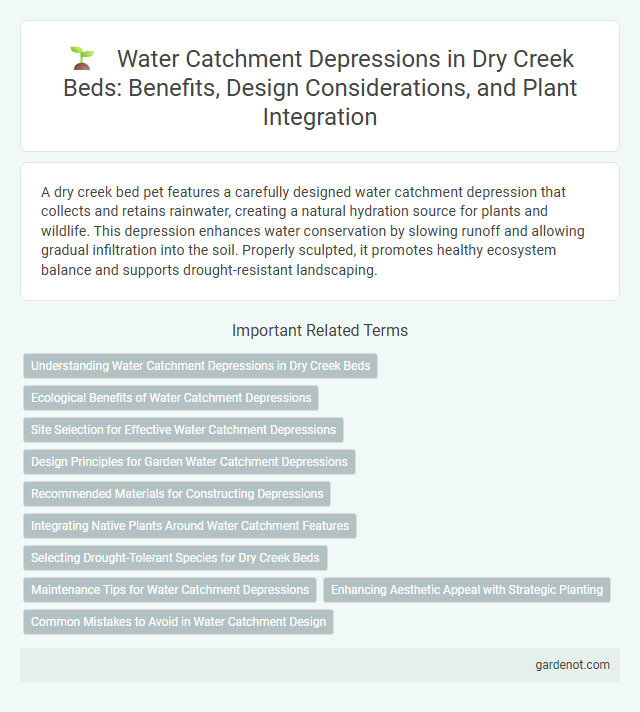A dry creek bed pet features a carefully designed water catchment depression that collects and retains rainwater, creating a natural hydration source for plants and wildlife. This depression enhances water conservation by slowing runoff and allowing gradual infiltration into the soil. Properly sculpted, it promotes healthy ecosystem balance and supports drought-resistant landscaping.
Understanding Water Catchment Depressions in Dry Creek Beds
Water catchment depressions in dry creek beds serve as natural reservoirs that capture and store runoff during rainfall events, facilitating groundwater recharge and supporting local ecosystems. These depressions vary in size and shape, influencing the amount of water retained and the duration it remains before evaporation or infiltration. Understanding their hydrological functions aids in managing water resources and mitigating flood risks in arid and semi-arid environments.
Ecological Benefits of Water Catchment Depressions
Water catchment depressions in dry creek beds serve as natural reservoirs that enhance groundwater recharge and support biodiversity by providing critical habitats for flora and fauna. These depressions promote soil moisture retention, which aids in sustaining vegetation during dry periods and reduces erosion. By capturing and slowly releasing runoff, water catchment depressions help maintain ecological balance and improve water quality in arid landscapes.
Site Selection for Effective Water Catchment Depressions
Selecting an optimal site for a water catchment depression involves analyzing topography to identify natural low points where runoff accumulates, maximizing water capture efficiency. Soil permeability and composition must be assessed to ensure adequate infiltration and minimize seepage losses in the dry creek bed area. Proximity to vegetation and existing water flow paths enhances the sustainability and ecological integration of the catchment system.
Design Principles for Garden Water Catchment Depressions
Water catchment depressions in garden design optimize rainwater harvesting by maximizing surface area and incorporating gentle slopes for efficient runoff flow. Using impermeable or semi-permeable liners can prevent seepage, while layering with organic mulch enhances water retention and soil moisture balance. Vegetation placement around the depression stabilizes soil, reduces erosion, and promotes groundwater recharge through natural infiltration.
Recommended Materials for Constructing Depressions
Recommended materials for constructing water catchment depressions in dry creek beds include compacted clay, geomembranes, and bentonite liners to enhance water retention and minimize infiltration. Natural materials like clay are favored for their impermeability, while synthetic liners provide durability and ease of installation. Incorporating geotextiles beneath liners can improve stability and prevent punctures, ensuring long-term functionality of the catchment depression.
Integrating Native Plants Around Water Catchment Features
Integrating native plants around water catchment depressions in dry creek beds enhances soil stability and reduces erosion, promoting sustainable water retention. Native species like buffalo grass, sedges, and desert willow improve infiltration rates and provide critical habitat for local wildlife while adapting to fluctuating moisture levels. Strategic planting around these features maximizes water capture efficiency and supports ecosystem resilience in arid environments.
Selecting Drought-Tolerant Species for Dry Creek Beds
Selecting drought-tolerant species for dry creek beds enhances water catchment efficiency by reducing evaporation and maximizing soil moisture retention. Native plants like sagebrush, yucca, and desert marigold thrive in water-limited environments due to their deep root systems and low transpiration rates. Incorporating these resilient species supports sustainable landscaping while maintaining ecological balance in arid regions.
Maintenance Tips for Water Catchment Depressions
Regularly remove accumulated debris and sediment from water catchment depressions to maintain optimal flow and prevent blockages. Inspect vegetation around the depression to ensure roots do not disrupt the structure or reduce water collection efficiency. Periodic monitoring and timely repairs of erosion or crusting help preserve the depression's capacity and longevity.
Enhancing Aesthetic Appeal with Strategic Planting
Strategic planting in a dry creek bed water catchment depression elevates aesthetic appeal by incorporating native grasses, flowering perennials, and drought-tolerant shrubs that thrive in arid conditions. These plants stabilize soil, reduce erosion, and create dynamic textures and seasonal color variations enhancing visual interest. Incorporating layered vegetation around the catchment depression mimics natural riparian ecosystems, enriching biodiversity and providing a visually cohesive landscape feature.
Common Mistakes to Avoid in Water Catchment Design
Water catchment depressions in dry creek beds often suffer from poor site assessment, leading to inadequate water retention and increased erosion risks. Overlooking soil composition and slope gradient results in inefficient water capture and potential structural failure. Ignoring proper filtration and sediment control further compromises water quality and catchment longevity.
Water catchment depression Infographic

 gardenot.com
gardenot.com